vertebrates 1 and 2
1/33
There's no tags or description
Looks like no tags are added yet.
Name | Mastery | Learn | Test | Matching | Spaced |
|---|
No study sessions yet.
34 Terms
vertebrates
fully developed backbone
more complex mode of movement and lifestyles
allow for the colonization of land
most recognize and visible group of organisms
most conspicuous
great ranges in sizes
worldwide distribution
swim, walk, run, fly
fishes are included
fish
first vertebrate
numbers exploded by the devonian period
60% of ___ are marine
have conquered all aquatic environments
ecological role is of great relevance for the functioning of the oceans
agnatha
most primitive fish alive today
lack paired appendages
very abundant during devonian period
two main groups: hagfish, lampreys
hagfish (agnatha group)
exclusively marine- deep and continental waters
some species found in intertidal zone in cold waters
lack of actual vertebrae, rest of the skeleton is cartilage
posees no paired fins, only a single continuous tail
scavengers (feed on dead animals)
important, commercially speaking, for their skin and meat
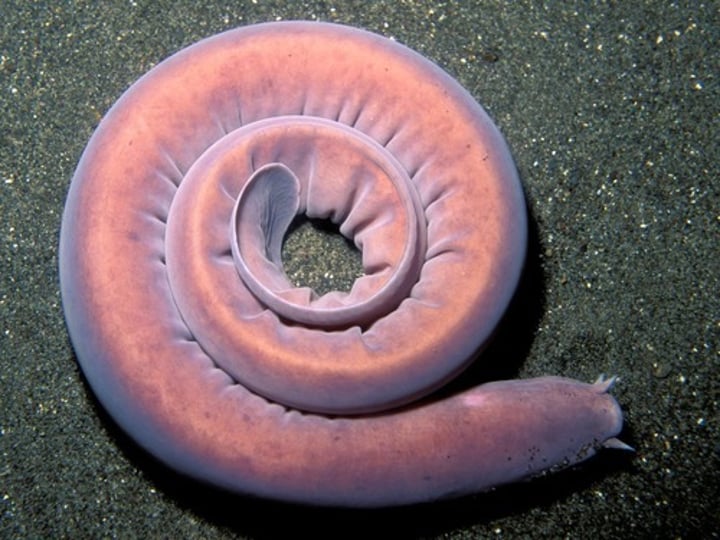
lampreys
coastal marine waters and some freshwater
not found in warm waters
no jaws, and no paired fins
cartilaginous skeleton
parasitic species
anadromous fish
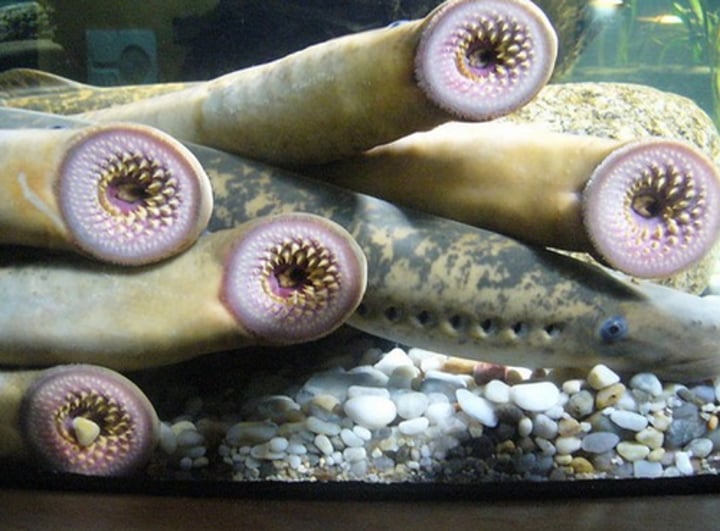
chondrichthyes
cartilaginous fish
very primitive
successful group of organism
first time in evolutionary history where articulated jaws and paired fins appear
upper jaw is not attached to the skull
integument shows a tough coating of denticles, placoid scales
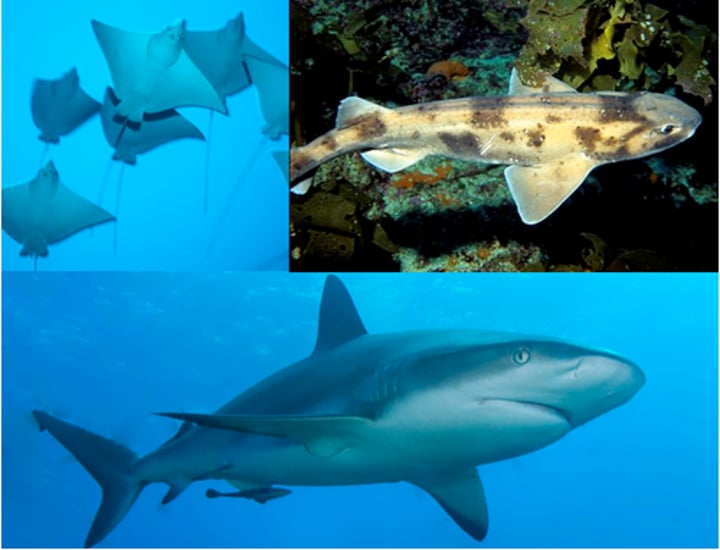
chondrichthyes- elasmobranch (sharks)
comprise about 450 species
mostly pelagic, body adapted to swimming continuously
predators (top and meso) some planktivory
lack fin rays, but have strong pectoral and caudal fins (both important for swimming and maneuvering)
no swim bladder
lack a gill cover or operculum
severely overfished
shark reproduction
internal fertilization (claspers)
oviparous (egg laying)
viviparous (live bearing, umbilical cord)
ovovivparous ( aplacental yolk sac)
chondrichthyes- elmasobranch (skate and rays)
flatten fish with pectoral fins expanded into wing like structures used for swimming
some capable of potent electric discharge
some plankton feeders, carnivorous
chondrichthyes -chimaeras
still have cartilaginous skeleton
upper jaw is fused to the skull
don't have scales
present an upper and lower grinding plate
deep sea fishes
dorsal fin spine is poisonous
nervous system adaptation of elasmobranch
olfactory system- great sense of smell, can detect very low concentrations of substances in the water
lateral line- detect physical disturbances and vibrations in the water, formed by neuromasts receptors organized into more sophisticated organ-like canals that run along the sides of the fish
apmpullae of lorenzini- formed by subcutaneous receptors capable of detecting electric impulses from prey, so efficient that they can detect prey buries in sand
osmoregulation adaptions (elasmobranch)
regulates water balance in body and maintains homeostasis
have isotonic blood
high urea concentration
ex sharks
swimming adaptations (elasmobranch)
sharks are denser than sea water and lack swimming bladder so they tend to sink
hydrodynamic body
have large oily liver
pectoral fins function as a wing, producing lift - counteracts the effect of the heterocercal caudal fin
present a horizontal keel in the caudal penduncle
present placoid scales
osteichthyes (bony fishes)
over 28,000 species
59% are marine
very diverse in forms and shape
skeleton made of bone
posses a swim ballder
osmoregulators- get rid of the excess salt via chloride cells in their gills
have different forms of locomotion (burrowing, crawling, walking, hovering, flying)
two basic groups: lobe-finned fishes, ray finned fishes
taxonomy always changing
lobe finned fishes (sarcopterygii)
subclass of bony fishes
textrapods evolved from this group
only 8 species exists today from this group of fish
skeleton made of both bone and cartilage
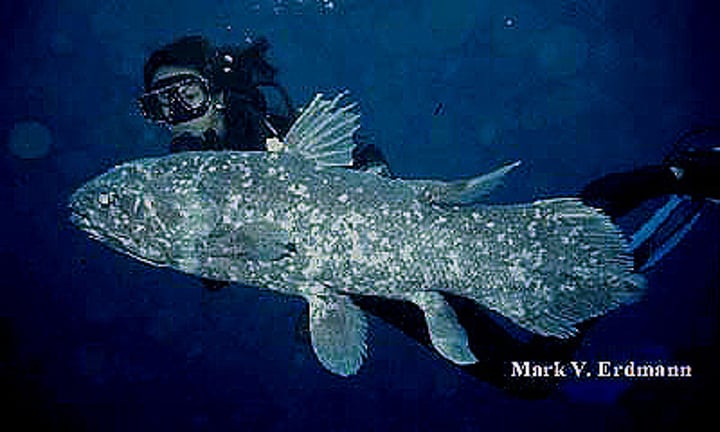
ray finned fish (actinopterygii)
subclass of bony fish
very diverse in forms and shape
fins attached to the body by rays, not fleshly lobes
have different forms of locomotion (burrowing, crawling, walking, hovering
two subclasses: chondrostei, neopterygii
chondrostei
subclass of ray finned fish
primitive fish
posses heterocercal tails and the position of spiracles similar to sharks and ray
skeleton made of cartilage
posses ganoid scales (thick and heavy)
marine and freshwater
neopterygii
subclass of ray finned fish
diverse in forms and shape
posses homocercal tails
bony skeleton
posses cycloid or ctenoid scales (thinner and flexible)
marine and freshwater
fish propulsion, general biology
all fish swim, but not in the same way
some are more efficient swimmers than others - strongly related to fish habits
two basic forms of swimming: anguilliform, thunniform
movement can be achieved by undulating the entire body, its tail (caudal fin), or just a few specific fins
thunniform
most efficient , high speed long distance swimmers
A form of swimming in fish involving very little body bending, thrust being generated by the tail
ex tuna
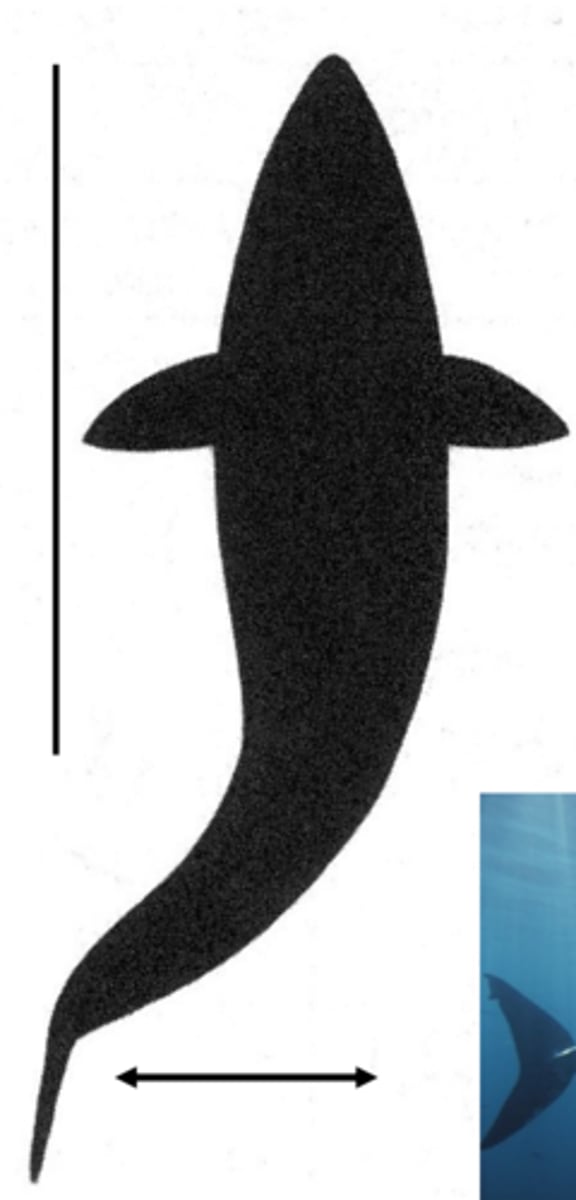
anguilliform
least efficient, have the form of an eel
its entire body, which is flexible throughout its complete length, moves in a series of sinuous waves passing from head to tail
rete mirabile
specialized countercurrent heat-exchange system
prevent metabolic heat from escaping into the surrounding water
shoal
group of fish, residing in the same area
may be the same species
not oriented in one direction
school
same species
same orientations and swim speed
depends on vision, so only occurs during daylight
also depends on lateral line
defense mechanism from predators and advantage for swimming efficiency, food location, reproduction
pod
in presence of predators
fish school contract into a bait ball
feeding (fish biology)
very diverse feeding mechanisms and food preferences
Piscivores, Planktivores, Detritivores, Herbivores.
All are heterotrophic.
reproduction (fish biology)
developed strategies to minimize predation
mostly sexual reproduction
some produce large numbers of eggs, others small numbers of eggs
some provide parental care
built nest
shark and rays lay eggs (oviparous)
some have eggs hatch inside them (ovoviviparous)
some give birth (viviparous)
migrations (fish biology)
aggregate to migrate to different areas
can be in the order to thousand Km, across an entire ocean basin, other are shorter
can be for reproductive feeding, or environmental conditions
diadromous
fish that move between ocean and freshwater for reproduction
anadromous
ocean-freshwater to reproduce
migrate up rivers from the sea
ex salmon
catadromous
freshwater-ocean to reproduce
migrate down rivers to the sea to reproduce
ex eels
amphidromous
fish that move freely between ocean and freshwater for not reproductive reasons
semelparity
when organisms reproduce only once during their life
iteroparity
when organisms reproduce multiple times during their life